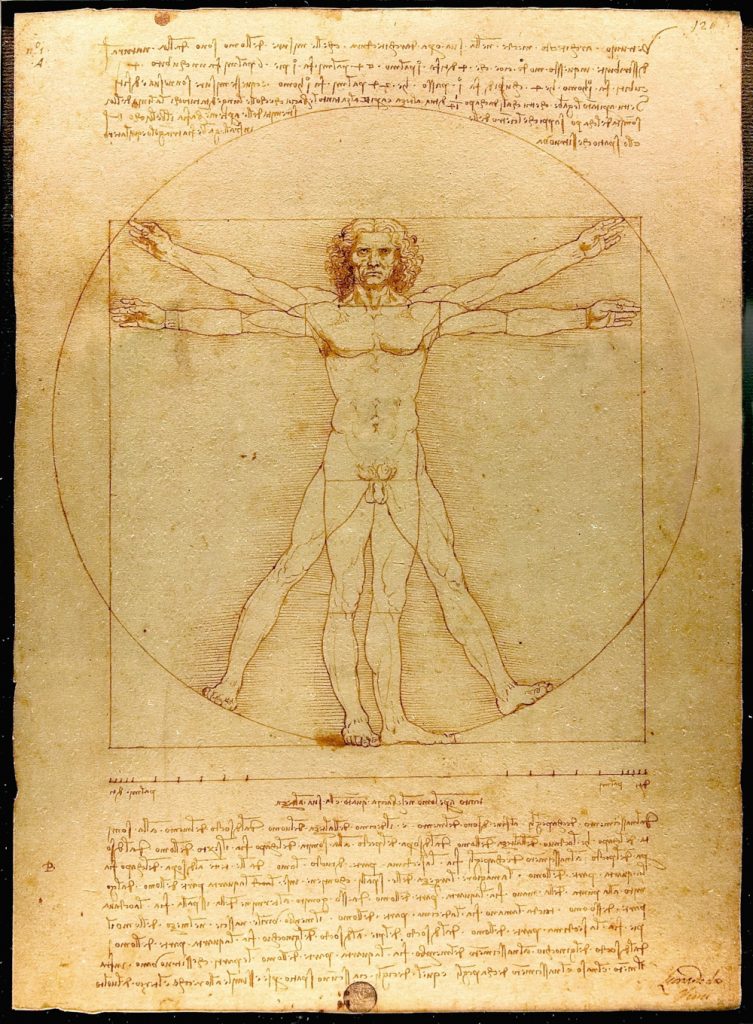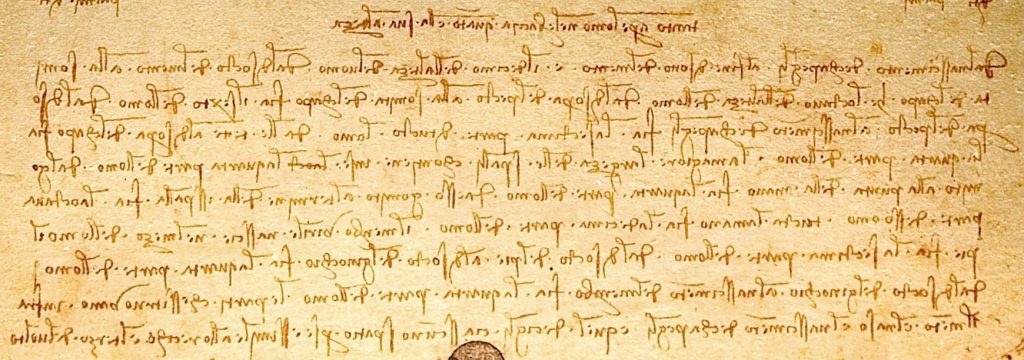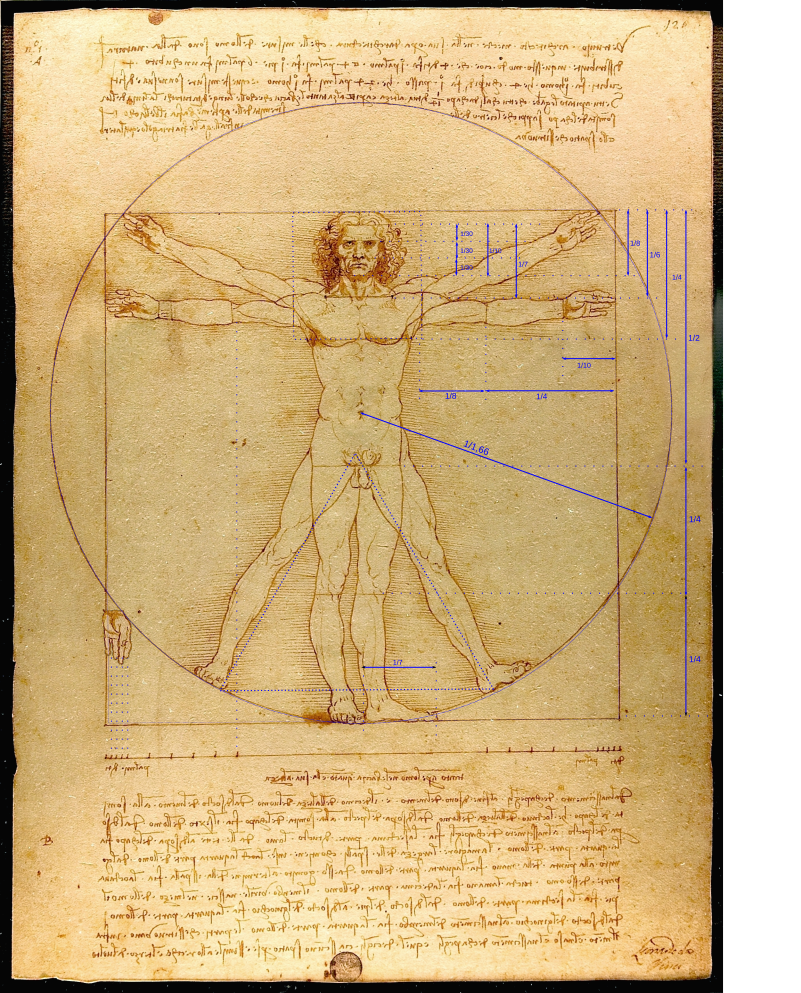This is a famous illustration by Leonardo da Vinci made in 1492. It is a study of the proportions of the human body. It gets this name because Leonardo made it from the texts of the architect of ancient Rome Marcus Vitruvius.
- Location: Emma Castelnouvo Room
- Minimum age: from 6 years old.
- Required time: 5 minutes.
- Number of participants: One or more people
- Keywords: proportions, human body, circle, square
- Taxonomy: Art, Geometry

The text at the top
The text accompanying the illustration is written in Italian and speculatively, as Leonardo wrote.
If you pass the pointer over the image it will be flipped speculatively.
Then you can read the old Italian text transcribed in the yellow box.
What is translated into Catalan is the text of the green box

Vetruvio, architecto, mecte nella sua op(er)a d'architectura, chelle misure dell'omo sono dalla natura
disstribuite inquessto modo cioè che 4 diti fa 1 palmo, et 4 palmi fa 1 pie, 6 palmi fa un chubito, 4
cubiti fa 1 homo, he 4 chubiti fa 1 step, he 24 palmi fa 1 homo ecqueste misure son ne' sua edifiti.
Settu ap(r)i ta(n)to le ga(m)be chettu chali da chapo 1/14 di tua altez(z)a e ap(r)i e alza tanto le b(r)acia che
cholle lunge dita tu tochi la linia della somita del chapo, sappi che 'l cie(n)tro delle stremita delle
Ello spatio chessi truova infralle ga(m)be fia tria(n)golo equilatero
Vitruvius, the architect says in his architectural work that nature distributes the measurements of the human body in this way: 4 fingers make a palm and 4 palms a foot, 6 palms make a forearm, 4 forearms make the height of man, 4 forearms make a step and 24 palms a man; and that these are the sizes he used in his buildings.
If you separate your legs enough to decrease your height by 1/14 and stretch and raise your arms until your fingers are at the upper level of your head, you should know that the geometric center of your limbs will be located in the navel and that the space between your legs will be an equilateral triangle.
Under the drawing is a line equal to the length of the side of the square, with the words written speculatively "palm" and "diti". The split marks of this segment show how 4 fingers make a palm and 6 palms the forearm. Leonardo actually draws his man's forearms a little smaller. Nor can the equilateral triangle of the feet be adjusted exactly.
It is plausible to understand that Leonardo cites Vitruvius as a source of inspiration and then make his own version of the proportions he does carefully follow in the drawing.
The text below
If you pass the pointer over the image it will be flipped speculatively.
Then you can read the old Italian text transcribed in the yellow box.
What is translated into Catalan is the text of the green box

Tanto ap(r)e l'omo nele b(r)accia, qua(n)to ella sua alteza.
Dal nasscimento de chapegli al fine di sotto del mento è il decimo dell'altez(z)a del(l)'uomo. Dal di socto del mento alla som(m)i-tà del chapo he l'octavo dell'altez(z)a dell'omo. Dal di sop(r)a del pecto alla som(m)ità del chapo fia il sexto dell'omo. Dal di so-p(r)a del pecto al nasscime(n)to de chapegli fia la sectima parte di tucto l'omo. Dalle tette al di sop(r)a del chapo fia la quarta parte dell'omo. La mag(g)iore larg(h)ez(z)a delle spalli chontiene insè [la oct] la quart parte dell'omo. Dal go-mito alla punta della mano fia la quarta parte dell'omo, da esso gomito al termine della isspalla fia la octava parte d'esso omo; tucta la mano fia la decima parte dell'omo. Il menb(r)o birile nasscie nel mez(z)o dell'omo. Il piè fia la sectima parte dell'omo. Dal di socto del piè al di socto del ginochio fia la quart parte dell'omo. Dal di socto del ginochio al nasscime(n)to del memb(r)o fia la quart parte dell'omo. Le parti chessi truovano infra il me(n)to e 'l naso e 'l nasscime(n)to de chapegli e quel de cigli ciasscuno spatio p(er)se essimile alloreche è 'l terzo del volto
The width of a man with outstretched arms is equal to his height.
From the birth of hair to the tip of the chin is the tenth part of a man. From the chin to
at the top of the head is the eighth part of the man. From above the chest to the top of the head is a sixth of the man. From above the chest to the birth of hair is the seventh part of the whole man. From the nipples the upper part of the head is a quarter of the man. The width of the shoulders is a quarter of the man. From the elbow to the tip of the hand is the fourth part of the man; The full hand is the tenth part of the man. The manly limb is in the middle of the man. The foot is the seventh part of the man. From the floor of the foot to below the knee is the fourth part of the man. From the knee to the beginning of the genitals is a quarter of the man. The distance from the bottom of the chin to the nose and from the birth of the eyebrows is in each case the same and like the ear, a third of the face.
Taking these proportions into the drawing we discover that Leonardo has incorporated non-anatomical lines to mark the limits of what he speaks of.
Correct the value of the foot: While Vitruvius says that a foot has 4 palms i.e. 4 ·( 1/24) = 1/6 of the height. Leonardo in the text below says it's 1/7 and actually draws it with that ratio.
There is a small mathematical inconsistency in the proportions of hair. He cites twice as a reference the beginning of hair, but the two differences do not coincide:
(1/8) – (1/10) = 1/40 and (1/6) – (1/7) = 1/42
A difference of 0'00119 between the two measures.
The ratio between the square side and the radius of the circle according to the drawing is 1.66. This value is approximately equal to 1.62 gold number . Regarding this proportion his friend Luca Pacioli wrote a treatise "The Divine Proportion" but in the works of Leonardo there is no mention of this proportion or the number of gold.

